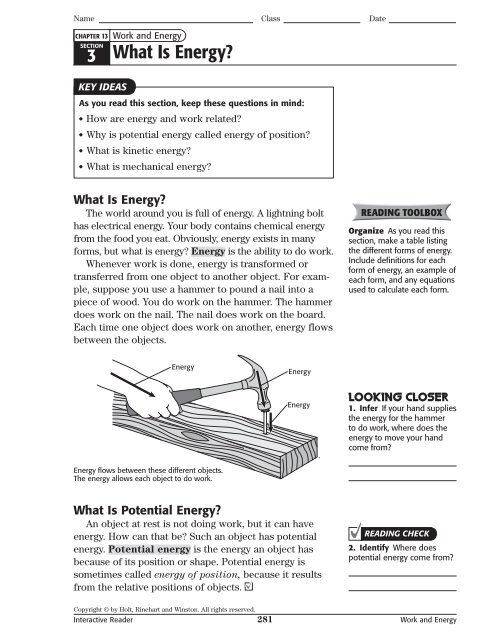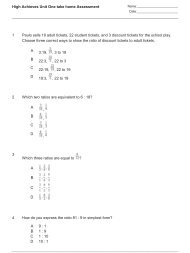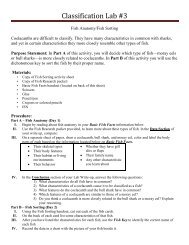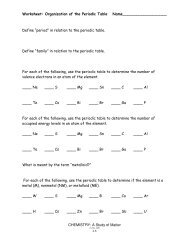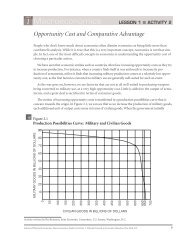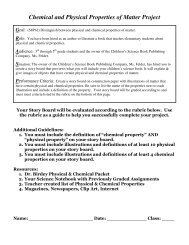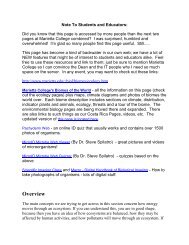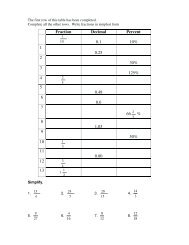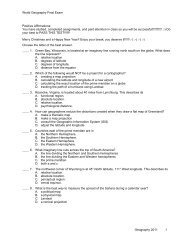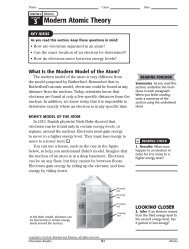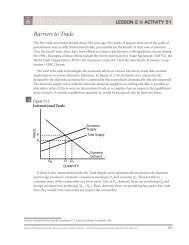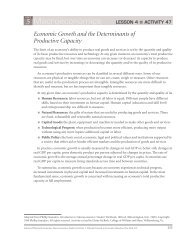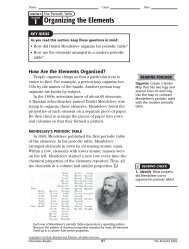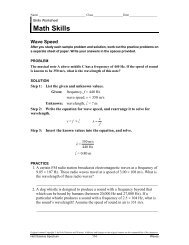3 What Is Energy?
3 What Is Energy?
3 What Is Energy?
You also want an ePaper? Increase the reach of your titles
YUMPU automatically turns print PDFs into web optimized ePapers that Google loves.
Name Class DateSECTION 3<strong>What</strong> <strong>Is</strong> <strong>Energy</strong>? continuedNUCLEAR ENERGYRemember that the strong nuclear force holds protonsand neutrons together in the nuclei of atoms. As a resultof this force, atomic nuclei contain potential energycalled nuclear energy. Some kinds of reactions canrelease this energy. For example, within the sun and mostother stars, atomic nuclei fuse, or combine. This nuclearfusion releases energy. People use nuclear fission, or thebreaking apart of nuclei, to produce electricity.ELECTRICAL ENERGYMost of the appliances that we use every day arepowered by electricity. Electricity is a form of electricalenergy, which comes from the movements of chargedparticles.Electrical energy is similar to gravitational potentialenergy. Charged particles move from areas of high electricpotential to areas of low electric potential. This is similarto what happens when an object falls to the ground. Whenthe charged particles move, they transmit energy.READING CHECK15. Identify Name twokinds of nuclear energy.LIGHT ENERGYThink about a hot, sunny day at the beach such asthe one in the figure below. <strong>Is</strong> the sand hotter underthe shade of the umbrella or where sunlight is shiningdirectly on the sand? You might guess, correctly, that thesand in the direct sunlight is hotter. The reason is thatsunlight carries energy. The energy from the sun heatsthe Earth.16. Explain Why is the sandcooler under the umbrellathan outside the umbrella?Electromagnetic waves carryenergy from the sun to Earth.Most objects absorb some ofthese waves. The energy inthe waves is then convertedto heat energy.Light energy travels from the sun to the Earth acrossempty space in the form of electromagnetic waves.Electromagnetic waves can travel through empty space.Copyright © by Holt, Rinehart and Winston. All rights reserved.Interactive Reader 287 Work and <strong>Energy</strong>
Name Class DateSection 3 ReviewSECTION VOCABULARYenergy the capacity to do workkinetic energy the energy of an object that isdue to the object’s motionmechanical energy the amount of work an objectcan do because of the object’s kinetic andpotential energiespotential energy the energy that an object hasbecause of the position, shape, or condition ofthe object1. Explain A boy on a bicycle is resting at the top of a hill. Then, he rides his bicycledown the hill. Describe how the boy’s potential and kinetic energy differ at thetop, middle, and bottom of the hill.2. Describe Fill in the table. Decide what form or forms of energy apply to eachsituation and whether each form is mechanical or nonmechanical energy.Situation Form(s) of <strong>Energy</strong> Mechanical ornonmechanical?Frisbee moving through the airkinetic and potential energyCup of hot soupnonmechanicalSunlightlight energyBoulder sitting at the top of a hillA lit lightbulbelectrical energy and light energy3. Apply Concepts Why are water storage tanks usually built on towers or hilltops?4. Calculate <strong>What</strong> is the potential energy of a 35 kg child sitting at the top of a slidethat is 3.5 m above the ground? <strong>What</strong> is her kinetic energy if she moves down theslide at a speed of 5.0 m/s? Show your work.Copyright © by Holt, Rinehart and Winston. All rights reserved.Interactive Reader 288 Work and <strong>Energy</strong>


